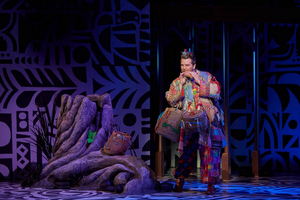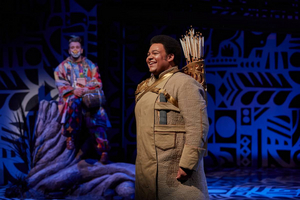Review: THE MAGIC FLUTE at Opera Theatre Of Saint Louis
The production runs through June 26.

The marvelous Opera Theatre of Saint Louis continues its festival season with perhaps the most popular opera in the world-Mozart's glorious The Magic Flute! It is a story of valiant effort winning through to enlightenment and optimism after terrible difficulties. This is most fitting, as OTSL returns to its beautiful indoor home after its heroic struggles over the past two "plague years".
This opera is a fantasy on Freemasonry, a movement which grew up fostered by the Enlightenment. Freemasonry was, essentially, a humanist rejection of the old hierarchical authority, and a commitment to human perfection through individual betterment. There was a fundamental optimism at its core.
Both Mozart and his librettist, Emanuel Schikeneder, were Freemasons.
 The story is half allegorical fairy-tale, half enigma, and half kaleidoscope of symbols. (And that's not all that doesn't add up in this great puzzle.) We, the uninitiate, have difficulty parsing all the symbols in this opera-but musically it is a scrumptious feast!
The story is half allegorical fairy-tale, half enigma, and half kaleidoscope of symbols. (And that's not all that doesn't add up in this great puzzle.) We, the uninitiate, have difficulty parsing all the symbols in this opera-but musically it is a scrumptious feast!
We are in Egypt. We are in the middle of a mystical, metaphysical struggle between the Powers of Darkness (embodied in the Queen of the Night) and the Powers of Light, led by Sarastro, the mighty Grand Master of his temple of Freemasonry.
Caught in the toils of this battle are young Prince Tamino and the lovely Pamina, daughter of the Queen of the Night. Now Pamina has been abducted by Sarastro, and her mother enlists Tamino to rescue her. Needless to say, from the moment Tamino sees Pamina's portrait he falls madly in love with her.
 As usual at OTSL the voices in this cast are sublime. The central role, Tamino, is sung by Joshua Blue, whose smooth, clear tenor is a joy. He has appeared in smaller roles in OTSL productions of La Rondine, The Trial, and Gianni Schicchi. His talents well merit this more demanding role.
As usual at OTSL the voices in this cast are sublime. The central role, Tamino, is sung by Joshua Blue, whose smooth, clear tenor is a joy. He has appeared in smaller roles in OTSL productions of La Rondine, The Trial, and Gianni Schicchi. His talents well merit this more demanding role.
Erica Petrocelli sings Pamina. At first I thought her voice a little too dramatic, a touch too dark for this innocent ingénue, but she soon won me over. Her voice can richly convey all the emotions, while masterfully integrating all those coloratura tricks and making them seem easy and natural. She is amazing-the most remarkable voice of the evening!
Jeni Houser, as the Queen of the Night, takes on the very most challenging coloratura aria in all of opera--the "Vengeance Aria", and she sings it with colors flying. With laser-like precision she delivers a sheer sparkling fireworks display of glittering notes.
Sarastro, the "High Priest of the Sun", is commandingly sung by basso Adam Lau (last seen here in Richard the Lionheart.)
Three magical ladies in service to the Queen of the Night are sung by Meghan Kasanders, Meridian Prall, and Stephanie Sanchez. Their beautiful voices are perfectly matched.
Ahh! And then there is Papageno, the bird-catcher! He's the comic center of the piece! He's a liar and a coward, yet he becomes Pamino's side-kick He's lonely and yearning for a sweet-heart. Dressed in rustic patch-work, Jonathan McCullough makes Papageno a total delight. He is a so-refreshing change from all the high-toned moral pontifications from Priests and Queens. McCullough's splendid comic gifts almost distract us from his very fine gifts as a baritone.
Angel Riley (as the bright, teasing Papagena) makes Papageno's dream come true.
Conductor Rory Macdonald leads his orchestra into true beauty in support of these fine voices.
So, musically this Magic Flute is a wondrous gift. But I have problems with some design elements and with some of Stage Director Omer Ben Seadia's choices.
The set, by Ryan Howell, is most appealing to the eye. The great walls and floor are covered with artistic black-and-white abstract patterns-like silhouettes, like lino-cuts. This is at first engaging, but eventually its busy-ness becomes distracting.
Long stairs ascend to a balcony at the rear. A huge, leafless twisted tree stands center stage.
A dozen or so slim neon tubes descend from the flies as needed, their colors changing-blue, green, purple, red, gold-as befits the mood of the scene. This treatment is so obvious and intentional--and does not always attain the desired mood.
I have many quarrels with Jessica Jahn's costumes. Tamino wears a sort of beige modern trench-coat. Yes, his right arm is covered with ornate golden armor--but, a colorless trench-coat for this fantasy prince?! The three magic ladies wear satiny monochrome dresses with great skirt-spillages of vividly colored tulle. Just a little tacky. The three child spirits who guide Tamino are bound together in one great blackish bag which is simply ugly.
All the attendants of the Temple wear unadorned white with the merest smudge of gray pattern on the skirts. I suppose all this white was intended to catch the changing colors of the light, but it doesn't always quite work. The minions of the Temple wear maroon modern jump-suits with oddly accordioned cowls.
The Queen of the Night should have an ENTRANCE!! Surely she should come down the grand stairway from the sky. But, no, she enters rather timidly from around behind the stairs. And she wears the very simplest of slim white evening gowns. She looks not like a mighty queen, but like Saint Joan about to be burnt at the stake. Her glorious "Vengeance" aria is completely blocked from many in the audience by Tamino, who is positioned down-stage of her. (To Jessica Jahn's credit, however, the Queen appears later in the evening wearing a stunningly designed gown and exotic head-piece--again, of brilliant lunar white.)
And then there's Monostatos, Sarastro's wicked captain of the guard, who lusts after Pamina. This is a problem role indeed. Monostatos is the Caliban of the piece, eager even to force his desires on the young damsel. Disloyal, cowardly, not too bright, he is morally unsalvageable. The libretto describes him as a "blackamoor". In Christian lands, in Mozart's time, Moors had long been viewed as infidels, and thus suspect and untrustworthy, perhaps evil (even long after 1492 when the Christian conquest of Granada ended the last Muslim rule in Spain).
So what's a modern director to do with this role? Can't be Black. Can't be Muslim. But he must be, like Caliban, visibly evil--somehow monstrous. The Queen of the Night's offering of Pamina to Monostatos should indelibly stamp her, the Queen (not Sarastro), as the baddy. One simply cannot present Monostatos as a young and handsome man in a trim jump-suit singing with the beautiful voice of Christian Sanders (who plays the role). Monostatos, whose approach to Pamina should make us cringe in horror, seems in this production to be a quite acceptable suitor for her. Go figger!
But the glorious music makes all these problems seem hardly significant.
It is, musically, a grand production of a sublime opera. And as for the symbolism! Is the Queen of the Night the Catholic Church? Or Maria Theresa? Or Lilith? Or just Superstition? Is Tamino Franz Josef? Try not to think about all that; just relax and listen to those voices!
For information visit https://opera-stl.org/
(Photos by Eric Woolsey)
Enter Your Article Text Here!
Add Your Comment
Play Broadway Games
Videos





%20(1024%20×%20512%20px).png)
